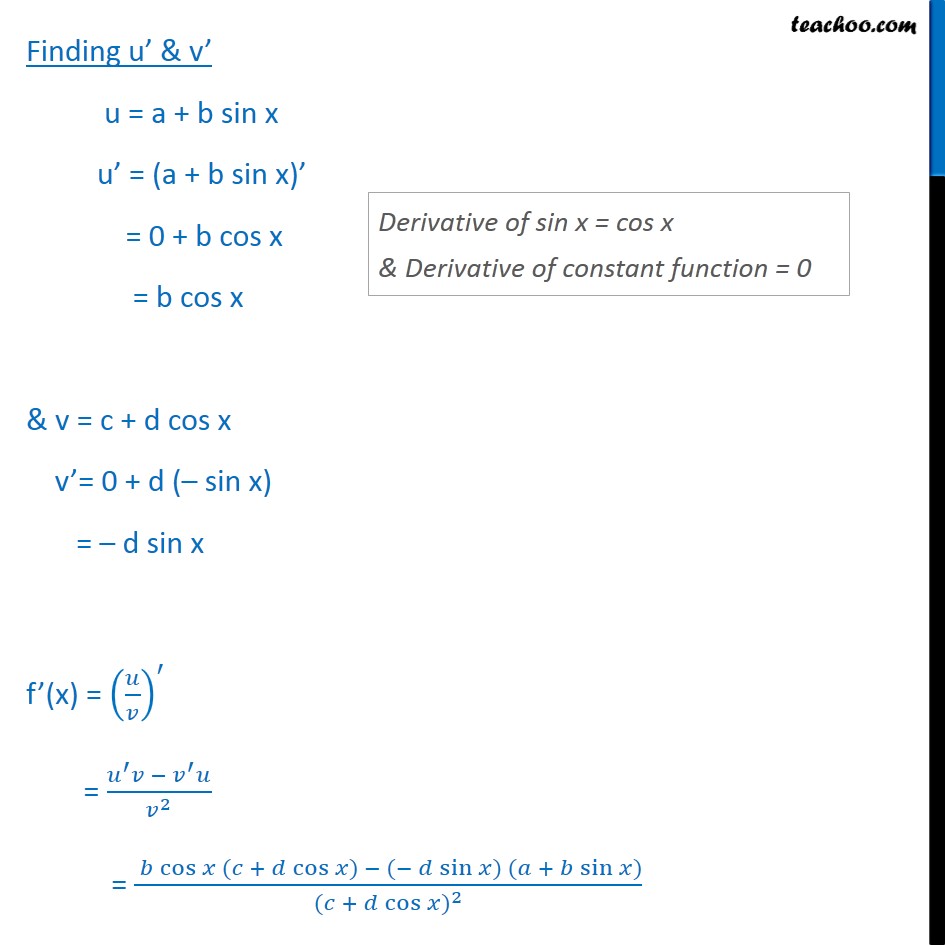


Miscellaneous
Last updated at Dec. 16, 2024 by Teachoo



Transcript
Misc 20 Find the derivative of the following functions (it is to be understood that a, b, c, d, p, q, r and s are fixed non-zero constants and m and n are integers): a + b sinxc + d cos x Let f (x) = a + b sinxc + d cos x Let u = a + b sin x & v = c + d cos x So, f(x) = 𝑢𝑣 ∴ f’(x) = 𝑢𝑣′ Using quotient rule f’(x) = 𝑢′𝑣 − 𝑣′𝑢 𝑣2 Finding u’ & v’ u = a + b sin x u’ = (a + b sin x)’ = 0 + b cos x = b cos x & v = c + d cos x v’= 0 + d (– sin x) = – d sin x f’(x) = 𝑢𝑣′ = 𝑢′𝑣 − 𝑣′𝑢 𝑣2 = 𝑏 cos𝑥 (𝑐 + 𝑑 cos𝑥) − (− 𝑑 sin𝑥) (𝑎 + 𝑏 sin𝑥) (𝑐 + 𝑑 cos𝑥)2 = 𝑐𝑏 cos𝑥 + 𝑑𝑏 𝑐𝑜𝑠2𝑥 + (𝑑 sin𝑥) (𝑎 + 𝑏 sin𝑥) (𝑐 + 𝑑 cos𝑥)2 = 𝑐𝑏 cos𝑥 + 𝑑𝑏 𝑐𝑜𝑠2𝑥 + 𝑎𝑑 sin𝑥 +𝑏𝑑 sin2𝑥 (𝑐 + 𝑑 cos𝑥)2 = 𝑐𝑏 cos𝑥 + 𝑑𝑏 (𝒄𝒐𝒔𝟐𝒙 + 𝐬𝐢𝐧𝟐𝒙) + 𝑎𝑏 sin𝑥 (𝑐 + 𝑑 cos𝑥)2 = 𝑐𝑏 cos𝑥 + 𝑑𝑏 𝟏+ 𝑎𝑑 sin𝑥 (𝑐 + 𝑑 cos𝑥)2 = 𝑐𝑏 cos𝑥 + 𝑎𝑑 sin𝑥 + 𝑑𝑏 (𝑐 + 𝑑 cos𝑥)2 ∴ f’(x) = 𝒄𝒃 𝒄𝒐𝒔𝒙 + 𝒂𝒅 𝒔𝒊𝒏𝒙 + 𝒅𝒃 (𝒄 + 𝒅 𝒄𝒐𝒔𝒙)𝟐